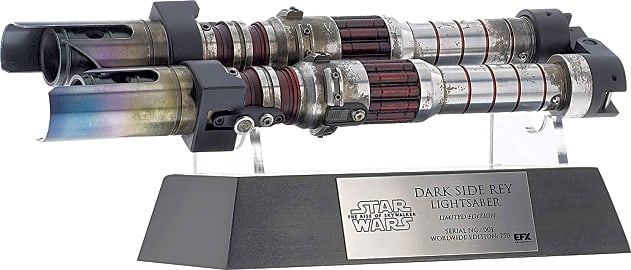The 8 Best Realistic Lightsabers

This wiki has been updated 38 times since it was first published in December of 2016. It's up to you whether you choose the Light Side or the Dark Side of the Force, but with one of these realistic lightsabers in your hand, you'll be well on your way to conquering the galaxy, no matter which path you take. They also make fine desk ornaments that are sure to charm fellow "Star Wars" fans, and could be the difference between winning and losing a costume contest. When users buy our independently chosen editorial selections, we may earn commissions to help fund the Wiki.
Editor's Notes
January 09, 2020:
This category gets a little personal for me, as I'm sure it does for the majority of fans serious enough to need the most realistic sabers they can find. The big problem here, of course, is that the materials that render the most realistic blades are often the least suitable for any kind of duelling contact. Now, for collectors, this isn't as serious a problem, but for cosplayers, LARPers, and members of lightsaber fighting organizations (they do exist), this is a significant issue.
Most collectors will be pleased with the models in our main ranking, especially the screen accuracy of the Star Wars Black Series Kylo Ren and the Dark Side Rey Limited Edition. The latter of those two is one of the few models to include a stand that's truly suitable to a collector's showcase, as it features an engraved plaque pointing out the rareness of the piece. Sadly, Rey's yellow lightsaber from the end of The Rise of Skywalker seems to be absent from the marketplace as of this writing.
For anyone that wants to actually fight with their lightsaber, we've linked to a number of dual-worthy lightsaber manufacturers in our special honors section. Among those, Saberforge's Elite series is likely the most exciting, as they have models that are clearly inspired by certain Star Wars characters, as well as designs from outside the canon, all of which are relatively inexpensive, so if they do get damaged in combat, you can always grab another.
Special Honors
Saberforge Elite Series These sabers are intended for full-contact duelling, with the ability to stand up to kendo bokkens in heavy combat. The company makes it a point to say that they aren't affiliated with the Star Wars brand, but a close examination of their most popular models will reveal some similarities to iconic weapons from the film series. They also have a number of original pieces that you might prefer for to establish your own style. Customization options are wide-reaching, but can get expensive. saberforge.com
Ultra Sabers Diamond You won't find any Star Wars replicas among this company's offerings, but you will find weapons suitable for competitive duelling. The built-in controller allows you to customize everything from the device's light color and intensity to the sound effects it makes as you use it. Their heaviest blade option is recommended for combat, but it does diminish the overall brightness just a bit. ultrasabers.com
The Perfect Fake Lightsaber
The plastic is clear, allowing you to see the opaque white blade beneath as it comes alive.
It’s nearly impossible to sit through any single one of the Star Wars movies without wanting desperately to wield a lightsaber. Even if you somehow manage only to see the prequel films, and you find that you feel more deeply connected to blaster combat, you will inevitably be overwhelmed by the desire to pick up a lightsaber and slowly, painstakingly cut Jar Jar Binks in half.
The odds are good that you’ve seen some of the original trilogy. And, if box office numbers are any indicator, it’s also pretty likely that you’ve seen The Force Awakens. It doesn’t matter how old or mature you are, how refined your tastes in modern art and classical music; Star Wars is for everyone. And with realistic lightsabers like the ones on our list, there’s no good reason the famous Jedi weapon shouldn’t be for everyone, as well. But how do these fake lightsabers go about imitating the real thing?
The best realistic lightsabers essentially exist in one of two states: extended, or on, and retracted, or off. In the on position, a light source illuminates a fiberglass blade housed in a layer of protective plastic. The plastic is clear, allowing you to see the opaque white blade beneath as it comes alive. In the off position, the blade lies dormant and white.
But that’s not exactly how a lightsaber in the off position looks in the movies. Well, since these devices can’t reasonably extend a blade of light from within their hilts (at least not at this level of realism), manufacturers opted instead for the fiberglass blades to be removable. You can leave the blade attached and unlit for display purposes on the lightsaber’s included stand, or you can remove the blade from the hilt, store it somewhere safe, and clip the metal hilt to your belt. Nothing adds a swagger to your step quite like a lightsaber dangling on your hip.
That hilt itself is outfitted with a motion sensor similar to the gyroscopic sensor in your cell phone. It also contains a simple sound board that has several officially licensed and sampled lightsaber sounds recorded onto it. As you wield your lightsaber, it will make appropriate sounds to correspond with speed, angle, and contact.
Quick note on safety: Just because these high-quality lightsabers are made from fiberglass, that doesn’t mean you should go out and try to construct your own. Most importantly, don’t make the mistake of engaging in a lightsaber duel using fluorescent light bulbs. They will shatter violently on contact, and they will release very unhealthy particles into the air.
The Perfect Real Lightsaber...That's Also Fake
The mechanics of the fictional lightsaber are a little more exciting than those of these excellent replicas. Even the way in which the filmmakers of the original trilogy created the famous effect is fascinating and admirable.
One bit of lightsaber trivia that’s particularly fascinating has to do with wounds inflicted by the weapon.
Fictional lightsabers draw their power from what are known as Kyber crystals. These crystals are in tune with the Force, and it’s believed that they have something akin to sentience. This is one of the reasons that the lightsaber in The Force Awakens seems to call out to Rey with voices and visions of her past and her future. When outfitted with a properly designed energy matrix, Kyber crystals can generate blades of plasma akin to the jets used in plasma arc welding, albeit in a larger, far more controlled output. That control comes mainly from the Force-sensitivity and training of the lightsaber’s handler.
One bit of lightsaber trivia that’s particularly fascinating has to do with wounds inflicted by the weapon. Lightsaber wounds rarely bleed, if they at all. The tremendous heat created by the plasma blade actually cauterizes the very wounds that it creates, burning closed any passageway for blood to flow.
The props that actors Mark Hamill and company wielded on set were pretty cool, but they were nothing like the fictional beams. To create a glowing effect, George Lucas and his team built the lightsaber props with motors in the hilt. These motors spun a reflective rod where the sword blade would be. The reflective material on these rods was intended to catch the glint of carefully placed set lights, and to create a natural glow.
The effect was hit or miss, with minor imperfections in the execution of fight choreography resulting in its utter failure. In post-production, artists actually went in and painted the lightsabers’ colors into place by hand, one frame at a time. Interestingly, if the original idea had worked, these famous weapons might not ever have had any particular color associated with them.
A Crystal Of A Different Color
We touched briefly above on the practical origins of lightsaber colors. Since the release of the first film, those colors have come to bear some meaning, enough that it should be one of your first considerations when purchasing a realistic lightsaber.
As the years wore on, these distinctions were less and less important.
Within the Star Wars canon, the Kyber crystals used in the creation of a lightsaber once indicated certain aspects of a Jedi’s style. Jedi of more physical prowess turned toward blue crystals. Those of a more contemplative nature gravitated toward green. Jedi with a heavy scholarly bent, augmented by admirable physical abilities, would be seen with yellow blades. The Sith, AKA the bad guys, manufactured their own crystals, which led to the red hues seen in use by notable baddies Darth Vader and Kylo Ren.
As the years wore on, these distinctions were less and less important. You’re welcome to take them into consideration, but the odds are that you’ll simply want a light saber associated with your favorite character.
Hilt style may also be of interest to you. As the film series has progressed, so to has the design complexity of the handles for characters’ lightsabers. Older styles are notably plainer, which announces to the world your affinity for the original trilogy. Newer styles have a bit more flair, and will show anyone who sees it that you’re all about keeping up with the latest in lightsaber technology.
You could also spend a long night searching your soul, investigating the darkest corners of your heart to determine your true relationship with the Force. You may find that your heart is a place of great darkness, and that only a Sith saber would ever do it justice. Then again, should there reside a kernel of hope somewhere beneath the frustration and pain of your everyday life, then you know what you must choose.













